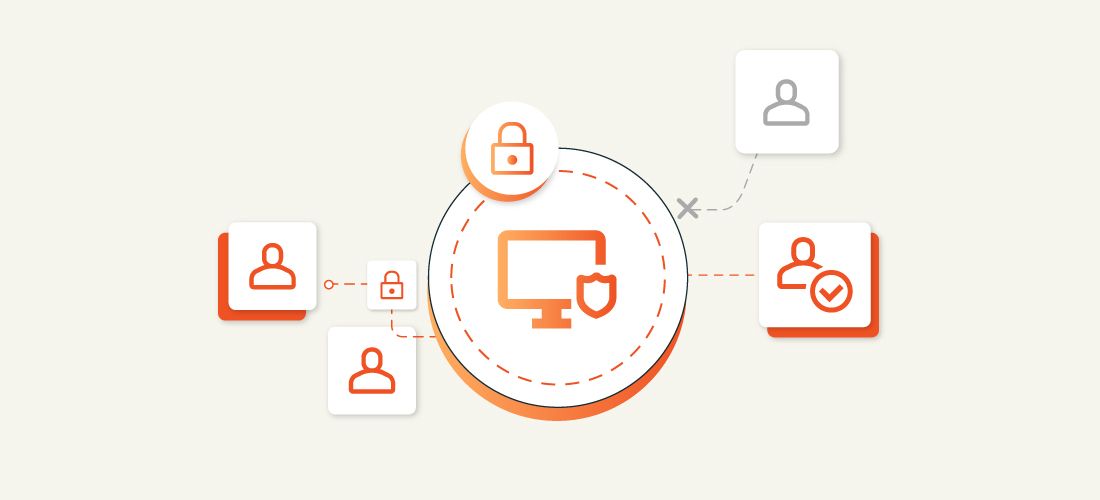
Identity is the new perimeter, with a staggering 80% of security breaches originating from compromised identities, and some estimates as high as 90% and above. That’s why a comprehensive identity threat detection and response (ITDR) strategy has never been more critical.
ITDR distinguishes itself as a broad security strategy, exemplifying an in-depth defense concept. It accomplishes this through a dual approach: seamlessly blending continuous monitoring and response mechanisms with a strong emphasis on proactive protective measures. This ensures a fortified security posture that is both resilient and adaptable.
In this article, we will delve into the preventative facets of a robust ITDR strategy, analyzing the direct threats and attacks targeting identities in today’s digital landscape alongside established solutions. Our aim is to provide a comprehensive understanding of how to effectively safeguard against these challenges.
The crucial role of identity threat detection and response
ITDR is a critical and prominent component in cybersecurity, designed to protect an organization’s assets and operations against identity-based risk. It encompasses a broad spectrum of tools and practices aimed at protecting identity infrastructures, detecting intrusions, enabling swift remediation and ensuring continuous compliance and protection. Given the sophisticated nature of modern cyberattacks, ITDR’s role in orchestrating a cohesive response to identity-based threats is indispensable.
Core prevention strategies in ITDR
Effective prevention is at the heart of every cybersecurity preparedness plan. It’s crucial for operational and security leaders to meticulously map out their identity infrastructure, evaluating the presence and efficacy of preventive measures. By integrating both established IAM protocols and innovative ITDR-specific strategies, organizations can align their security measures with their unique risk profiles and business objectives. Essential preventive strategies include:
Vulnerability mitigation
Focuses on preemptively identifying and remedying vulnerabilities in identity systems. It encompasses timely software updates and patch management, secure configuration practices and the employment of advanced authentication mechanisms like multi-factor authentication (MFA). Additionally, regular audits and access reviews, coupled with the principle of least privilege, ensure that only authorized users have access to essential resources, significantly reducing the attack surface.
Attack surface reduction (ASR)
Involves minimizing potential entry points for attackers by eliminating unnecessary or overly broad access privileges, thereby hardening the security landscape. This can be achieved in part through the implementation of multi-factor authentication (MFA) to add layers of verification, enforcing least privilege access controls to limit user access to only what’s necessary for their role and conducting regular access reviews to ensure access rights remain aligned with job functions.
Additionally, adopting a zero trust architecture that requires verification for every access attempt, regardless of the user’s location or device, further reduces the attack surface. There are also specialized ASR tools tailored for specific identity systems such as Active Directory, Entra ID and Okta. These tools are designed to identify Tier 0 assets and pathways to them, recommend mitigation steps to close these pathways and continuously monitor these assets for any unauthorized changes.
Configuration integrity
Entails upholding stringent configuration standards for identity and access management (IAM) solutions, ensuring continuous monitoring for any irregularities and swiftly addressing any issues to prevent exploitation. This includes establishing baseline security configurations that align with industry best practices and regulatory requirements to protect against common vulnerabilities. For instance, configuring multi-factor authentication (MFA) for all user accounts enhances security by requiring additional verification beyond just passwords.
Additionally, automated tools can be utilized to monitor configurations in real time, alerting administrators to any unauthorized changes that could indicate a breach or misconfiguration. By promptly reverting such changes, organizations can maintain the integrity of their IAM configurations and thwart potential security threats.
These foundational strategies underscore the importance of a proactive and informed approach to securing identity systems, emphasizing the need for a robust, multi-layered defense mechanism tailored to the specific challenges and objectives of each organization.
Tailoring preventive controls to specific identity attacks and threats
An informed understanding of identity-based attacks enables the implementation of precise preventive controls, effectively neutralizing the threat they pose. Here’s how strategic alignment between threats, attacks and controls can bolster cybersecurity defenses:
Password spraying and brute force attacks
These attacks aim to access a vast array of accounts using commonly used passwords, frequently sourced from initial access brokers (IAB) on the dark web. Attackers often employ sophisticated patterns to avoid anomaly detection systems. According to Microsoft, the adoption of multi-factor authentication (MFA) creates a formidable barrier against password spraying and brute force attacks, blocking over 99.9% of such attempts. By introducing additional layers of identity verification, MFA significantly diminishes these attacks’ efficacy.
Credential scanning and stuffing
Credential stuffing entails automated attempts to access accounts with previously breached credentials, exploiting users’ tendency to reuse passwords across multiple services. Conversely, scanning involves systematically searching for vulnerable accounts that can be exploited due to weak security practices. Passwordless logins offer a revolutionary countermeasure, eliminating the primary target of such attacks by removing passwords from the authentication process altogether.
Golden and silver ticket attacks
Golden and silver ticket attacks target the Kerberos authentication protocol, a cornerstone of network security in Windows environments. In a golden ticket attack, attackers compromise the Key Distribution Center’s (KDC) Ticket Granting Ticket (TGT) service to create tickets that grant them unauthorized access to any resource within a Microsoft Active Directory environment. This level of compromise effectively gives the attacker the same rights as a domain administrator, allowing them to access systems, modify permissions and exfiltrate data undetected.
Silver ticket attacks, on the other hand, involve forging a Service Ticket (ST) without the need to compromise the TGT. By targeting a specific service, such as the file server or a database, attackers can gain unauthorized access to these resources directly. While silver tickets offer a narrower scope of access compared to golden tickets, they can be more insidious by bypassing certain types of logging and detection mechanisms, making the attack harder to detect and mitigate.
Both attacks leverage flaws in the Kerberos authentication system to bypass security controls, maintaining persistence and stealth within the targeted environment, posing a significant threat to organizational security.
Implementing privileged access management (PAM) ensures rigorous scrutiny and control over access rights, particularly for high-privilege users, thereby limiting the potential damage from these attacks. Privileged identity management (PIM) complements this by providing a framework for the secure storage, management and monitoring of privileged credentials, further securing access to critical systems and data.
ITDR solutions play a crucial role in bolstering Active Directory security by implementing best practices and standards to prevent attacks like golden ticket attacks. This includes measures such as restricting access to critical accounts like KRBTGT and safeguarding the domain database through proactive measures and response strategies. By employing these tactics, ITDR solutions help mitigate the risk of unauthorized access or manipulation within the Active Directory environment.
Thwarting Kerberoasting attacks
When targeting service accounts in a Windows environment, these attacks exploit weak service account passwords. Foiling Kerberoasting requires a strategic approach to safeguard Active Directory environments. First, assess your environment from an attacker’s perspective, identifying accounts at risk of Kerberoasting—those with a Service Principal Name (SPN), an outdated password and significant privileges. Utilize tools like PowerShell, reporting systems, vulnerability analysis tools or advanced software to pinpoint these vulnerable accounts.
Upon identifying at-risk accounts, various mitigation strategies can be employed. Where possible, transition services to use computer accounts or managed service accounts, which inherently manage password changes securely. If these options aren’t viable, employing a privileged information manager (PIM) can automate the process of regularly updating service passwords with long, random combinations. In scenarios where PIM isn’t an option, manually update passwords regularly, prioritizing accounts with the oldest passwords and highest privileges.
Additionally, monitoring for signs of Kerberoasting, such as service tickets issued with RC4-HMAC encryption, is indicative of potential attacks. This activity can be detected through Event 4796 on domain controllers, specifically looking for the “Ticket Encryption Type” with the Hex code 0x17. Activating Audit Kerberos Service Ticket Operations will increase audit events significantly, necessitating the use of a SIEM system or specialized event log analysis software to manage the volume and focus on critical RC4 service ticket events.
Alternatively, implementing change auditing software that audits RC4 encryption types, allows for account whitelisting and offers real-time alerting can streamline this process without the need to audit every service ticket operation, providing a more efficient way to detect and respond to Kerberoasting attempts.
Pass-the-hash and man-in-the-middle attacks
Mitigating pass-the-hash and man-in-the-middle attacks necessitates a multifaceted approach, combining various defensive measures to safeguard against credential interception and unauthorized access. Endpoint Detection and Response (EDR) systems are pivotal in detecting and responding to suspicious activities, while robust encryption protocols ensure the confidentiality and integrity of data in transit, thwarting interception attempts.
Additionally, implementing multi-factor authentication (MFA) fortifies authentication processes, requiring multiple credentials for access and mitigating the impact of compromised passwords. Role-based access control (RBAC) further tightens security by precisely defining user privileges based on their roles, limiting the potential damage of successful attacks.
Network segmentation, coupled with network access control (NAC) solutions, constrains lateral movement within the network and prevents unauthorized access. Furthermore, Secure Socket Layer (SSL)/Transport Layer Security (TLS) protocols, DNS security practices and VPN solutions augment defenses by encrypting data, securing DNS queries and providing secure remote access, respectively. Employing this comprehensive security framework significantly strengthens defenses against pass-the-hash and man-in-the-middle attacks, ensuring robust protection of organizational assets.
Preventing privileged escalation
These attacks occur when attackers aim to illicitly gain elevated access rights. Foundational to this prevention effort are privileged access management (PAM) and identity governance and administration (IGA) systems. PAM tools are essential for securing, controlling and monitoring access to critical assets by managing privileged accounts and credentials, effectively reducing the risk of unauthorized access.
IGA solutions complement this by ensuring proper identity lifecycle management, including provisioning, deprovisioning and role management, thereby ensuring that users have appropriate access levels based on their roles and responsibilities.
In addition, identity threat detection and response (ITDR) can also play a role in preventing privileged escalation by ensuring the most critical accounts are protected against unauthorized changes. Together, these solutions form a robust defense against privilege escalation by limiting the exposure of excessive privileges in the event of a credential compromise, ensuring that access is granted based on the principle of least privilege and is closely monitored and controlled.
Restricting the threat of lateral movement
This involves attackers moving within a network to reach high-value targets. To effectively counter lateral movement in identity-based attacks, employing a comprehensive security strategy is crucial. Tools and techniques like network segmentation and micro-segmentation further protect critical assets by restricting access points and restricting movement. Endpoint detection and response (EDR) systems enable the detection of and response to suspicious movements. Importantly, cloud infrastructure entitlement management (CIEM) plays a pivotal role by managing cloud identities and minimizing unnecessary privileges, thereby reducing the attack surface. Together, these approaches form a layered defense against the sophisticated tactics used in lateral movement, ensuring the integrity of networked systems and sensitive data.
Embracing ITDR
In the journey toward cybersecurity excellence, embracing ITDR is not merely an option—it’s a necessity. As we’ve discussed, ITDR stands as a model of the defense-in-depth strategy, seamlessly integrating prevention, detection and response mechanisms. This holistic approach does not just aim to preempt threats before they manifest but also ensures a swift and effective response to incidents as they occur, embodying the very essence of proactive and reactive security measures.
For organizations to fortify their defenses, the establishment of core ITDR strategies is paramount. This involves a meticulous process of mitigating vulnerabilities, reducing the attack surface and continuously monitoring for configuration drift and unauthorized changes. By doing so, organizations can create a resilient framework that not only withstands the test of cyber threats but also evolves with them.
However, the journey doesn’t stop at establishing these strategies. To truly combat the array of risks presented by sophisticated identity attack vectors, deploying a comprehensive suite of solutions is indispensable. These solutions must be adept at addressing the volume of known identity threats and attack methods highlighted throughout our discussion. From thwarting password spraying and brute force attacks with MFA to neutralizing credential stuffing and scanning through passwordless technologies, each control plays a critical role in the overarching strategy.
But beyond the technical implementations, the strength of an ITDR strategy lies in its adaptability and the organization’s commitment to cybersecurity culture. This includes fostering an environment where continuous learning, vigilance and the adoption of best practices are ingrained in every facet of the organization. It’s about creating a culture where every stakeholder understands their role in the cybersecurity ecosystem and is equipped to act on it.
Moreover, the effectiveness of ITDR strategies hinges on their alignment with the organization’s specific risk profile and business objectives. Tailoring these strategies to address unique vulnerabilities and threats ensures not only the security of digital assets but also the integrity and continuity of business operations. It’s a dynamic process that requires ongoing assessment, refinement and adaptation to the ever-evolving cybersecurity landscape.
Conclusion
In summary, embracing identity threat detection and response (ITDR) is a journey towards creating a more secure, resilient and trusted digital environment. By weaving prevention, detection and response into the fabric of cybersecurity strategies, organizations can not only defend against current threats but also anticipate and prepare for future challenges. This proactive and comprehensive approach to ITDR not only safeguards the organization’s assets and reputation but also reinforces its commitment to excellence in cybersecurity.



